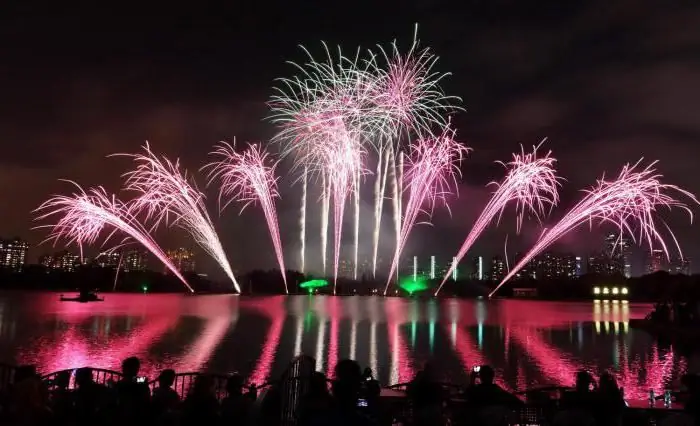- Author Harold Hamphrey [email protected].
- Public 2023-12-17 10:06.
- Last modified 2025-01-24 11:10.
Kotlin Island is a small piece of land with an area of sixteen square kilometers, located in the B altic Sea. From an administrative point of view, it belongs to the Kronstadt district of St. Petersburg. According to researchers, it was formed about 5.5 thousand years ago. As of today, the island is an object of national historical heritage.

A Brief History
According to historians, the Scandinavian Vikings were the first people who visited here approximately in the seventh century. The oldest documented memories of Kotlin date back to the thirteenth century. At that time, it played the role of an important stopping point for merchants traveling from Novgorod to Europe, as well as in the opposite direction. According to the Orekhov peace treaty signed in 1323, the Novgorod principality and Sweden jointly owned the island, and in 1617, according to the Stolbovsky agreement, it completely became the property of the Scandinavian state. Almost a hundred years later, Russia regained it during the Northern War. May 7, 1704 herecompleted the construction of fortifications. Thus, it is now generally accepted that on this day a port city was founded on the island of Kotlin, which bears the name of Kronstadt.
Over the past two centuries, this piece of land from time to time several times became the main base of the B altic Fleet - first of the Russian Empire, and later of the Soviet Union, which was largely due to the loss of strategic positions in the B altic States and Finland. It remains so today, in the days of the Russian Federation.

Geography
Scientists say that Kotlin Island was formed after one of the ice ages as a result of a change in the nature and direction of currents in the Gulf of Finland. It happened approximately 5, 5 thousand years ago. In fact, it is a washed-out moraine, the dimensions of which are 11 and 2 kilometers long and 2 kilometers, respectively. Supporters of this version have recently become more and more, which is facilitated by studies of recently discovered geological deposits here, which in a number of indicators correspond to the bottom of the B altic Sea.
The shape of the island is slightly elongated in the direction from southeast to northwest. Several bays have formed on the coast, which are very convenient for anchoring ships. As for the relief of Kotlin, it is predominantly flat and has small hills over the entire surface. The highest points are above sea level at around 15 meters.
Inhabitants
A port city located on the island of Kotlin, according to the latestcensus, inhabited by about 45 thousand people. The inhabitants of Kronstadt, in fact, are the population of this entire piece of land in the B altic Sea. From an ethnic point of view, the predominant majority of the people living here are Russians. In addition to them, small groups of representatives of other nationalities live here, now inhabiting the countries of the former USSR.

Climate
A humid, temperate type of climate dominates over the territory on which Kotlin Island is located. In connection with the activity of cyclones, air masses here often change their direction of movement. The weather in the Gulf of Finland has a great influence on local temperature indicators. In summer, the air usually warms up to an average of 20-25 degrees above zero. As for precipitation, they fall here in the form of rain, snow or fog. Their average annual number ranges from 630 to 650 millimeters. In winter, winds usually blow from the southwest, and in summer - from the northwest. Compared to St. Petersburg climate, Kotlin is characterized by higher humidity.
Animals and flora
Kotlin Island is completely composed of soil of medium podzolic and inequigranular types. The result of the intensive and long life of people was that the natural flora was almost completely replaced by anthropogenic. Representatives of the local fauna are mainly domestic animals of the people living here. A few centuries ago, a large population of seagulls lived in this place, but it was almost completely exterminated due to human activity.

Tourist attraction
The city on the island of Kotlin rightfully belongs to the historical and cultural heritage of the Russian Federation. This is not surprising, since over the past few centuries Kronstadt has become one of the centers of events that have had a significant impact on the further development of the country. There are many monuments on its territory, for the sake of which travelers from all over the world come here. The most significant are: St. Nicholas Naval Cathedral and St. Vladimir's Cathedral. The construction of the latter started in 1730. As practice shows, most of the visitors to the island come here for historical knowledge. In this regard, local guides recommend tourists to visit the Marine Plant Museum, the A. S. Popov Memorial Museum, the Italian Palace and the Kronstadt Admir alty. Forts, a lighthouse and other protective historical fortifications cannot be ignored. It should be noted that there is even a small beach on Kotlin open for swimming in summer.

How to get there
After Kronstadt lost its military closed status, tourists from Russia and other countries began to come here regularly. Although there is a small airfield here, it serves solely to meet the transport needs of the army. Ferries and passenger ships regularly running from St. Petersburg to the port on Kotlin Island are considered the most common method of travel here. In addition, getyou can also get to Kronstadt by road over the bridge connecting it with the mainland.






